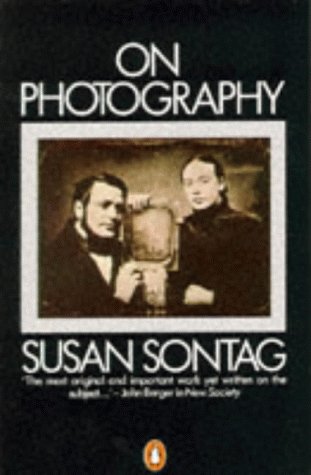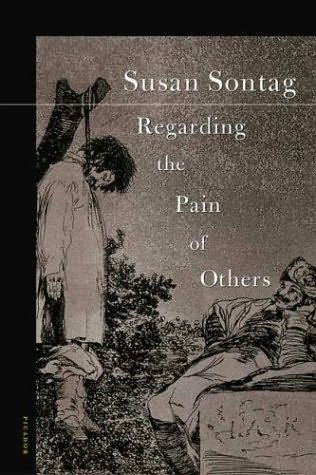Susan Sontag: from On Photography to Regarding the Pain of Others

Susan Sontag’s On Photography is a collection of essays that originally appeared in the New
York Review of Books. Sontag explores photography from the
perspective of the viewers, subjects, and photographers. She considers photographs as objects,
photography as a medium, the evolution of the technology, the use of the camera
by amateur picture-takers and professional image-makers. This collection is firmly grounded in
the 1970s and so reflects Sontag’s turn toward a postmodern critique of our
“image-world.” She argues that we
have become “image-junkies” consuming photographs that have translated all
experience into image (On Photography,
20). Photographs both allow access to a privileged vision of the
world that would have been unthinkable without the camera while at the same
time mediate our understanding of what we see and translate our experience into
a depersonalized encounter with only an image. Sontag suggests that the excess of images in our world have
inured us to the power of photography so that “the image-surfeited are likely
to find sunsets corny; they now look, alas, too much like photographs” (On Photography, 77). Sontag concludes
by considering the difficulty of distinguishing between images and reality in
her current cultural moment.
Written thirty years after the publication of her
foundational text On Photography,
Sontag’s Regarding the Pain of Others reconsiders many of her  earlier assertions as she writes about images
of atrocity within the context of the recent wars in Iraq and Afghanistan. In this 2003 collection of essays, Sontag
explores the history of documenting horror and argues that “our failure” in the
face of images of atrocity is a failure of “imagination, of empathy: we have
failed to hold this reality in mind” (Regarding,
8). Sontag’s insistence that we have failed to hold reality
it mind reverses her original assertions about “image-surfeited” society. This reversal seems all the more
surprising in that her recent work is written within the context of the rise of
digital photography and digital manipulation of the photographic image. Miles Orvell, photography scholar,
labels our current period the “post-photographic”—a moment in which digital
images blur the distinction between what is real and what may be imagined. What is most significant for Orvell
about post-photographic images—images that seem to move beyond a Barthesian
insistence that the “photograph always carries its referent with itself”—is
that they still rely on the reality of the referent (Barthes, 5). In other words, what makes these
photographs powerful is the persistence of the referent in the image that makes
‘real’ what can only be imagined.
earlier assertions as she writes about images
of atrocity within the context of the recent wars in Iraq and Afghanistan. In this 2003 collection of essays, Sontag
explores the history of documenting horror and argues that “our failure” in the
face of images of atrocity is a failure of “imagination, of empathy: we have
failed to hold this reality in mind” (Regarding,
8). Sontag’s insistence that we have failed to hold reality
it mind reverses her original assertions about “image-surfeited” society. This reversal seems all the more
surprising in that her recent work is written within the context of the rise of
digital photography and digital manipulation of the photographic image. Miles Orvell, photography scholar,
labels our current period the “post-photographic”—a moment in which digital
images blur the distinction between what is real and what may be imagined. What is most significant for Orvell
about post-photographic images—images that seem to move beyond a Barthesian
insistence that the “photograph always carries its referent with itself”—is
that they still rely on the reality of the referent (Barthes, 5). In other words, what makes these
photographs powerful is the persistence of the referent in the image that makes
‘real’ what can only be imagined.
In Regarding the Pain of Others, Sontag ends by asserting the failure of the
photograph to truly represent the reality of atrocity. As Sontag argues, the photograph can
only document the pain—can only prove to us that the atrocity is “real,” but cannot
communicate pain because the viewer is unable to “understand. We don’t get it. We truly can’t imagine what it was
like” (Regarding, 125).
The horror of these images of atrocity, then, comes not from their
aestheticizing pain and not from the possibility that they may be digitally
altered and therefore ‘unreal,’ but that these images may be only real. The horror of images of pain and death
is in their refusal of fantasy; the viewer cannot imagine himself or herself
into the photograph.
In some ways, Regarding the Pain of Others is a stark reversal of her earlier work On
Photography. Originally arguing that we have become inured to the
spectacle of suffering in a culture mediated through images and inundated with
representations of violence, Sontag now castigates the audacity of presuming
everyone a spectator and so suggesting “perversely, unseriously that there is
no real suffering in the world” (Regarding,
110). The translation of suffering into
spectacle is repugnant, but assuming that suffering is only spectacle is
violently dismissive. Postmodern
claims about the spectacle of images mean nothing to a person being
tortured. It is very difficult to
argue away the objectivity of pain.
What is difficult, as Sontag indicates, is to truly communicate
the pain of others. Here she
returns to an earlier assertion from On Photography that “only that which narrates can make us
understand” (On Photography, 21).
She notes a failure of communication and her solution for this failure
in 1973 was the caption. This
attempt at communication through captioning, tenuous as it was for Sontag
thirty years prior, no longer seems an option by 2003. While regarding the pain of others, we
simply “can’t understand, can’t imagine” (Regarding,
126). Pain defies accurate
representation. The problem with
regarding the pain of others is that we can only look; we cannot
understand. Perhaps we are in a
post-photographic world not because the photograph has failed to capture
reality, but because the photograph of pain can only capture reality. These photographs are not failures of
reality; they are failures of fantasy.
They do not fail to represent ‘real’ pain; they fail to allow us to
imagine it.
Works Cited
Barthes, Roland. Camera Lucida: Reflections on Photography. New
York: Hill and Wang, 1981. Trans. Richard Howard.
Orvell, Miles. American
Photography. Oxford: Oxford University Press, 2003.
Sontag, Susan. On
Photography. New York:
Farrar, Straus and Giroux, 1973.
Rpt. 1977.
______. Regarding
the Pain of Others. New York: Picador, 2003.
Recent comments
2 years 29 weeks ago
2 years 44 weeks ago
2 years 44 weeks ago
2 years 50 weeks ago
3 years 4 weeks ago
3 years 4 weeks ago
3 years 4 weeks ago
3 years 6 weeks ago
3 years 6 weeks ago
3 years 6 weeks ago